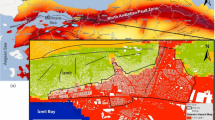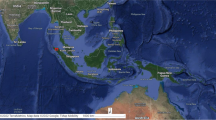Abstract
In this paper, an integrated urban earthquake vulnerability assessment framework, which considers vulnerability of urban environment in a holistic manner and performs the vulnerability assessment for the neighborhood scale, is proposed. The main motivation behind this approach is the inability to implement existing vulnerability assessment methodologies for countries like Turkey, where the required data are usually missing or inadequate for the decision-makers in prioritization their limited resources for risk reduction in the administrative units from which they are responsible for. The methodology integrates socio-economical, structural, coastal, ground condition, vulnerabilities (fragilities), as well as accessibility to critical services. The proposed methodology is implemented for Eskisehir, which is one of the metropolitans of Turkey. In the implementation of the proposed framework, geographic information system (GIS) is used. While the overall vulnerabilities obtained for neighborhoods are mapped in GIS, the overall vulnerabilities obtained for buildings are visualized in 3D city model. The main reason behind using different mapping and visualization tools for vulnerabilities is to provide better ways for communicating with decision-makers. The implementation of the proposed vulnerability assessment methodology indicates that an urban area may have different vulnerability patterns in terms of structural, socio-economical, and accessibility to critical services. When such patterns are investigated, effective vulnerability reduction policies can be designed by the decision-makers. The proposed methodology well serves for this purpose.











Similar content being viewed by others
References
Adapazari Chamber of Industry and Commerce (2000) Adapazari’nda Deprem ve Sonrasi, (Earthquake in Adapazari and after), Adapazari
Akdur R (2001) Afetlere Karsı Sağlık Hizmeti Senaryoları Yazma: Deprem Orneği (Writing up Scenarios of Health Services in Disaster Situations: The Case of Earthquake). http://www.bsm.gov.tr/umke/ftp/afetlerde_saglik_hizmeti_senaryolari.pdf
Alexander D (2000) Confronting catastrophe: new perspectives on natural disasters. Oxford University Press, New York
Badri MA, Mortagy AK, Alsayed CA (1996) A multi-objective model for locating fire stations. Eur J Oper Res 110:243–260
Bommer J, Spence R, Erdik M, Tabuchi S, Aydınoglu N, Booth E, del Re D, Peterken O (2002) Development of an earthquake loss model for Turkish catastrophe insurance. J Seismol 6:431–446
Boore DM, Joyner WB, Fumal TE (1997) Equations for estimating horizontal response spectra and peak acceleration from Western North American earthquakes: a summary of recent work. Seismol Res Lett 68(1):128–153
Code (1997) Specifications for structures to be built in Disaster areas. General Directorate of Disaster Affairs, Ministry of Public Works and Settlement, Ankara (in Turkish)
Crocker L, Algina J (1986) Introduction to classical and modern test theory. Harcourt Brace Jovanovich College Publishers, Fort Worth, pp 119–122
Cronbach LJ (1951) Coefficient alpha and the internal structure of tests. Psychometrika 16(3):297–334
Cummins PR, Laura S, Kong L, Sakate K (2009) Introduction to ‘‘tsunami science four years after the 2004 Indian Ocean tsunami, part I: modelling and hazard assessment. Pure Appl Geophys 165:1983–1989
Cutter SL (2003) The vulnerability of science and the science of vulnerability. Ann Assoc Am Geogr 93(1):1–12
Cutter SL, Boruff BJ, Shirley WL (2003) Social vulnerability to environmental hazards. Soc Sci Q 84(2):242–261
Davidson R, Shah HC (1997) A multidisciplinary urban earthquake disaster risk index. Earthq Spectra 13(2):211–223
Deniz A (2006) Estimation of earthquake insurance premium rates for Turkey. M.Sc. Thesis, Department of Civil Engineering, METU, Ankara
Deniz A, Yucemen MS (2010) Magnitude conversion problem for the Turkish earthquake data. Nat Hazards. doi:10.1007/s11069-010-9531-8
Dowrick DJ (2002) Earthquake risk reduction actions for New Zealand, technical conference of New Zealand sciety of earhquake engineering, Napier
Dowrick DJ (2003) Earthquake risk reduction. Wiley, New York
Erdik M, Demircioglu M, Sesetyan K, Durukal E, Siyahi B (2004) Earthquake hazard in Marmara region, Turkey. Soil Dyn Earthq Eng 24:605–631
Ertugay K, Duzgun HSB (2006) Integrating physical accessibility of emergency establishments into earthquake risk assessment. In: ECI conference: geohazards—technical, economical and social risk evaluation 18–21 June 2006, Lillehammer, Norway. Paper 45
Evans GW, Kantrowitz E (2002) Socioeconomic status and health: the potential role of environmental risk exposure. Annu Rev Public Health 23:303–331
FEMA-NIBS (1999) HAZUS: user’s manual and technical manuals, vol 1–4. Federal emergency Management Agency and Institute of Building Sciences, Washington, DC
GDDA-ERD (2004) Internet page of the Earthquake Research Department of Turkey, General Directorate of Disaster Affairs, Ministry of Public Works and Settlement, Ankara. TURKNET, http://sismo.deprem.gov.tr/VERITABANI/turknetkatalog.php
Gulkan P, Kalkan E (2002) Attenuation modeling of recent earthquakes in Turkey. J Seismol 6:397–409
Hewitt K (1997) Regions of risk: a geographical Introduction to Disasters. Logman, Harlow
ISC (2004a) Internet page of the Earthquake Research Department of Turkey. General Directorate of Disaster Affairs, Ministry of Public Works and Settlement, Ankara. ISC Based, http://sismo.deprem.gov.tr/VERITABANI/isckatalog.php
ISC (2004b) Internet page of the International Seismological Centre, International Seismological Centre, Thatcham, United Kingdom. On-line Bulletin, http://www.isc.ac.uk/Bull
Izmit Kent Kurultayi (2000) Kocaeli Deprem Sonrası Demografik, Ekonomik ve Sosyal Durumu, Arastirma Dizisi, (Demographic, Economic and Social Conditions After Kocaeli (in Marmara Region) Earthquake), Izmit Kent Kurultayı-Yerel Gundem 21, Kocaeli
Kakhandiki A, Shah H (1998) Understanding time variation of risk crucial implications for megacities worldwide. Appl Geogr 18(1):47–53
Karaman H, Sahin M, Elnashai S (2008) Earthquake loss assessment features of Meaviz-Istanbul (Hazturk). J Earthq Eng 12(S2):175–186
Kasapoglu A, Ecevit M (2001) Depremin Sosyolojik Arastırmasi, (Sociological Research of Earthquake), Sosyoloji Dernegi Yayınlari, no.6, Ankara
Kemec S, Duzgun HSB (2006a) Use of 3D visualisation in natural disaster risk assessment for urban areas. In: Abdulrahman A, Zlatanova S, Coors V (eds) Lecture notes in geoinformation and cartography series, innovations in 3D geo information systems. Springer, New York, pp 557–566
Kemec S, Duzgun HSB (2006b) 3-D visualisation of urban earthquake risk, ECI conference: geohazards—technical, economical and social risk evaluation 18–21 June 2006, Lillehammer, Norway
King SA, Kiremidjian AS (1994) Regionak seismic hazard and risk analysis through geographic information systems. The John A. blume earthquake center report no: 111. Blume Center, Standford California
Kocyigit A (2005) Personal communication. Department of Geological Engineering, METU, Ankara
KOERI (2004) Internet page of the Kandilli Observatory and Earthquake Research Institute. Bogazici University, Istanbul, Catalogue, http://www.koeri.boun.edu.tr/sismo/veri_bank/mainw.htm
Kolbe TH, Gröger G, Plümer L (2005) CityGML-interoperable access to 3D city models. In: Oosterom PJM, Zlatanova S, Fendel EM (eds) Proceedings of the international symposium on geo-information for disaster management on 21–23 March 2005 in Delft. Springer, Berlin
Kuntay O (1990) Erisilebilirlik kesin bir oncelik planlama dergisi. J Chamb City Plan 90:1–7
Makri M-C, Folkesson C (1999) Accessibility measures for analyses of land use and travelling with geographical information systems. Department of Technology and Society, Lund Institute of Technology, Lund University & Department of Spatial Planning, University of Karlskrona/Ronneby, Sweden
Marincioni F (2007) Information technologies and the sharing of disaster knowledge: the critical role of professional culture. Disasters 31(4):459–476. Blackwell Publishing, USA
Martin D, Higgs G (1997) The visualization of socio-economic GIS data using virtual reality tools. Trans GIS 1(4):255
Mileti DS (1999) Disasters by design: a reassessment of natural hazatds in the United States. Joseph Henry Press, Washington, DC
Morales ALM (2002) Urban disaster management: a case study of earthquake risk assessment in Cartago, Costa Rica, ITC Publication Series, no. 96, international institute for geo-information science and earth observation (ITC), Enschede, The Netherlands
Mourouse P, Brun B (2006) Presentation of risk-EU project. Bull Earthq Eng 4:323–339
Musson RMW (2000) Intensity-based seismic risk assessment. Soil Dyn Earthq Eng 20:353–360
Ordaz M, Aguilar A, and Arboleda J (2003) CRISIS2003, ver. 1.2.100, program for computing seismic hazard. Instituto de Ingeniería, UNAM, Mexico
Plattner T (2005) Modeling public risk evaluation of natural hazards: a conceptual approach. Nat Hazards Earth Syst Sci 5:357–366
Radius (1999) Risk assessment tools for diagnosis of urban areas against seismic disasters report. http://www.geohaz.org/contents/publications/RADIUS_RiskAssessment.pdf
Raper JF (1989) The 3D geoscientific mapping and modeling system: a conceptual design. In: Raper JF (ed) Three dimensional applications in geographical information systems. Taylor and Francis, London, pp 11–20
Servi M (2004) Assessment of vulnerability to earthquake hazards using spatial multicriteria analysis: Odunpazari, Eskisehir case study. M.S. Thesis, Geodetic and Geographic Information Technologies, METU, Ankara
Stafford PJ, Strasser FO, Bommer JJ (2007) Preliminary report on the evaluation of existing loss estimation methodologies, NERIES Project Report
Stepp JC (1973) Analysis of completeness of the earthquake sample in the Puget Sound area. In: Handing ST (ed) Contributions to seismic zoning. NOAA technical report ERL 267-ESL 30, US Department of Commerce
Strasser FO, Bommer JJ, Sesetyan K, Erdik M, Çagnan Z, Irizary J, Goula X, Lucantoni A, Sabetta F, Bal IE, Crowley H, Lindholm C (2008) A comparative study of European earthquake loss estimation tools for scenario in Istanbul. J Earthq 12(S2):246–256
Synolakis CE, Bernard EN, Titov VV, Kanoglu U, Gonzalez FI (2008) Validation and verification of tsunami numerical models. Pure Appl Geophys 165:2197–2228
Tucker BE, Trumbull JG, Wyss SJ (1994) Some remarks concerning worldwide urban earthquake hazard and earthquake hazard mitigation. In: Tucker BE, Erdik M (eds) Issues in urban earhquake risk. Kluwer, Dordrecht, pp 1–10
Turkey Statistics Office (2004) Poverty survey [in Turkish]. News Bull 2006:27. Available from: http://www.tuik.gov.tr/OncekiHB.do. Accessed 25 Sept 2010
US Department of Health, Human Services, (2002) Communicating in a crisis: risk communication guidelines for public officials. Department of Health and Human Services, Washington, DC
USGS (2004a) Internet page of the United States Geological Survey. U.S. Department of the Interior, Reston, VA. USGS/NEIC (PDE) 1973—Present, available on-line at http://neic.usgs.gov/neis/epic/epic_global.html
USGS (2004b) Internet page of the United States Geological Survey. U.S. Department of the Interior, Reston, VA. Significant Worldwide Earthquakes (2150 B.C.–1994 A.D.), available on-line at http://neic.usgs.gov/neis/epic/epic_global.html
Whitman RV (1973) Damage probability matrices for prototype buildings. R73-57, Department of Civil Engineering, Massachusetts Institute of Technology, Cambridge
Yakut A, Kucukcoban S (2005) A scenario based seismic damage estimation for Istanbul. In: International conference on 250th anniversary of the 1755 Lisbon earthquake, CD-ROM paper no 32, Lisbon, Portugal
Yiing-Jenq C, Nicole H, Cheng-Hua L, Shu-Ling T, Long-Shen C, Hong-Jen C (2004) Who is at risk of death in an earthquake? Am J Epidemiol 160(7):688–695
Yucemen MS (2005) Probabilistic assessment of earthquake insurance rates for Turkey. Nat Hazards 35:291–313
Yucemen MS, Ozturk NY (2008) Assessment of seismic hazard due to active faults. In: Proceedings, structural reliability and its applications APSSRA’08. The Hong Kong University of Science and Technology, Hong Kong, June. pp 253–258
Yucemen MS, Ozcebe G, Pay AC (2004) Prediction of potential damage due to severe earthquakes. Struct Saf 26(3), 349–366
Zlatanova S (2008) SII for emergency response: the 3D challenges. In: Chen J, Jiang J, Nayak S (eds) Proceedings of the XXI ISPRS congress, Part B4-TYC IV, July 2008. Beijing, pp 1631–1637
Zlatanova S, Rahman AA,Pilouk M (2002). 3D GIS: current status and perspectives. In: Proceedings of the joint conference on geo-spatial theory, processing and applications. 8–12 July, Ottawa, Canada
Acknowledgments
The authors would like to thank the anonymous reviewer for the accurate reading of the manuscript and providing valuable comments on the initial manuscript. This research work is partly supported by the Institute of Natural and Applied Sciences, Middle East Technical University (Project No: BAP-08-11-DPT2002K120510). The authors also express their thanks to Eskisehir Greater Metropolitan Municipality and Odunpazari Municipality for providing data for the application of the case study, Dr. Fatima Gunes for her invaluable efforts during the implementation of field surveys for socio-economical vulnerability, Prof. Dr. Ali Kocyigit for his contributions to the delineation of seismic source zones, and Mr. Mehmet Servi for providing the building damage data for Odunpazari.
Author information
Authors and Affiliations
Corresponding author
Rights and permissions
About this article
Cite this article
Duzgun, H.S.B., Yucemen, M.S., Kalaycioglu, H.S. et al. An integrated earthquake vulnerability assessment framework for urban areas. Nat Hazards 59, 917–947 (2011). https://doi.org/10.1007/s11069-011-9808-6
Received:
Accepted:
Published:
Issue Date:
DOI: https://doi.org/10.1007/s11069-011-9808-6




